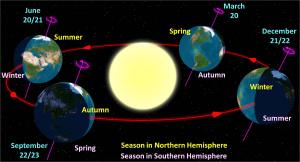Blog
Why Does Autumn Begin
On Different Days
of the Year?
23 September 2015
 The State of New Hampshire
The State of New HampshireToday is the first day of Autumn (or the first day of Spring for those in the southern hemisphere). This year it happens to fall on September 23, but that date can vary from the 21st to the 24th. So why doesn’t Autumn begin on the same day every year?
It all has to do with our swiftly tilting planet. The marking of Fall traditionally comes with the equinox, when the Sun’s path through the sky takes it from rising due East to setting due West. Since our seasons are caused by the tilt of Earth’s axis relative to its orbital plane, the equinox roughly marks the transition from longer periods of daylight to shorter ones or vice versa. The Earth’s axis remains fairly constant relative to the stars as it orbits the Sun, so its orientation relative to Sun changes over a year. So it would seem that the Autumnal Equinox should begin on the same day every year.
 Wikipedia user Tauʻolunga
Wikipedia user TauʻolungaBut the problem is that a solar year isn’t an exact number of days. Typically we consider 365 days to be a year, but a solar year is actually 365.2421897 days long. So a typical calendar year is a bit shorter than a solar year, and leap years are a bit longer. Because of this mismatch we’ve had to modify and refine our calendars over the centuries.
Since we can’t align a solar year with an integer number of days, there will always be a bit of drift between our calendar days and the day of the equinoxes and solstices. But even if a solar year happened to be exactly 365 days, over the centuries the marking of the seasons would still drift relative to the calendar year. While the Earth’s axis is fairly constant relative to the stars, it isn’t exactly constant. Over time the Earth’s axis precesses due to gravitational interactions with the Sun and Moon, causing Earth to wobble a bit like a top. Over geologic time scales the seasons can shift significantly.
So enjoy your first day of Autumn. The next one will occur on September 22, 2016.